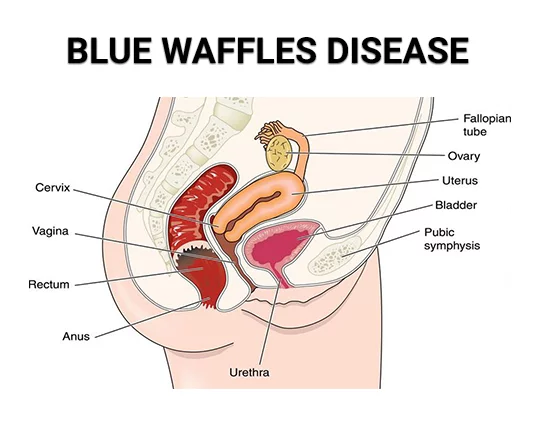The internet is a vast repository of information, but it’s also a breeding ground for myths and misinformation, especially when it comes to health-related topics. One such persistent urban legend is the so-called “Blue Waffles” disease. The term has circulated online for years, sparking curiosity, confusion, and even fear among those who stumble across it. This article aims to separate fact from fiction, diving into the origins of the Blue Waffles myth, exploring why it gained traction, and providing a clear, medically grounded perspective on the reality behind this sensationalized term. By addressing the keywords Blue Waffles, myth, and medical reality, we’ll clarify what’s true, what’s not, and why this hoax continues to mislead people.
The Origins of the Blue Waffles Myth
The term “Blue Waffles” first emerged in the early 2000s, primarily on internet forums, shock websites, and social media platforms. It was purported to be a sexually transmitted infection (STI) that caused severe symptoms, including a distinctive blue discoloration of the vaginal area, extreme swelling, and painful lesions. Accompanying the term were graphic images that allegedly depicted the condition, designed to shock and disgust viewers. These images, often manipulated or entirely fabricated, played a significant role in spreading the myth, as they lent a false sense of legitimacy to the claims.However, medical professionals and health organizations quickly debunked Blue Waffles as a nonexistent condition. No credible medical literature, peer-reviewed studies, or health authorities, such as the Centers for Disease Control and Prevention (CDC) or the World Health Organization (WHO), have ever documented a disease called Blue Waffles. The term appears to have originated as a hoax, likely intended to exploit people’s fears about STIs and their lack of knowledge about sexual health.The myth gained traction due to the internet’s ability to amplify sensational content. Shock value, coupled with the anonymity of online platforms, allowed the Blue Waffles narrative to spread rapidly. People shared the images and stories out of curiosity, disgust, or a desire to prank others, inadvertently perpetuating the misinformation. The lack of accessible, reliable sexual health education at the time also contributed to the myth’s persistence, as many individuals were unsure whether such a condition could exist.
Why the Blue Waffles Myth Persists
The Blue Waffles myth thrives in part because it taps into deep-seated fears about sexual health and STIs. Conditions like chlamydia, gonorrhea, and herpes are real and can have serious consequences if untreated, so the idea of a mysterious, visually shocking disease fits into existing anxieties. The graphic images associated with Blue Waffles, while fake, exploit this fear by presenting a grotesque and exaggerated depiction of what an STI might look like. This visual component makes the myth more memorable and shareable, even if the information is false.Another factor is the stigma surrounding sexual health. Many people feel uncomfortable discussing STIs or seeking medical advice, which creates a vacuum where misinformation can flourish. Instead of consulting a doctor or reputable source, some individuals turn to the internet for answers, where they encounter myths like Blue Waffles. The lack of open, honest conversations about sexual health in many communities further exacerbates this problem, allowing hoaxes to fill the gaps in knowledge.Social media platforms, including X, have also played a role in keeping the myth alive. Although the Blue Waffles trend peaked in the late 2000s and early 2010s, posts referencing it still appear occasionally, often as jokes or memes. These posts, while not always malicious, can confuse younger users or those unfamiliar with the hoax, leading them to believe Blue Waffles is a real medical condition. The cyclical nature of internet trends means that old myths can resurface, especially when paired with new images or stories that reignite curiosity.
The Medical Reality: No Such Thing as Blue Waffles
From a medical perspective, Blue Waffles is not a recognized disease or condition. The symptoms described in the myth—blue discoloration, severe swelling, and extreme pain—are not consistent with any known STI or medical condition. While some STIs, such as herpes or human papillomavirus (HPV), can cause visible symptoms like sores or warts, none produce the dramatic blue hue or exaggerated effects attributed to Blue Waffles. The images circulated online are either digitally altered or depict unrelated medical conditions, often taken out of context to shock viewers.Real STIs have well-documented symptoms and causes. For example:
- Chlamydia can cause abnormal discharge and pain during urination but is often asymptomatic, especially in women.
- Gonorrhea may lead to discharge, burning sensations, or pelvic pain, but it does not cause blue discoloration.
- Herpes results in painful sores or blisters, typically localized and not accompanied by extreme discoloration.
- Bacterial vaginosis, while not an STI, can cause odor and discomfort but is treatable and unrelated to the Blue Waffles description.
If someone experiences unusual symptoms in their genital area, such as pain, swelling, or discoloration, it’s critical to seek medical attention from a healthcare professional. These symptoms could indicate an infection, allergic reaction, or other condition, but they are not evidence of Blue Waffles. Self-diagnosing based on internet images or stories can lead to unnecessary panic and delay proper treatment.
The Dangers of Health Misinformation
The Blue Waffles myth highlights the broader issue of health misinformation online. False narratives can have real-world consequences, including:
- Fear and anxiety: Believing in a fake disease can cause undue stress, particularly for young people or those with limited access to accurate information.
- Delayed treatment: People may avoid seeking medical help for real conditions out of fear or embarrassment, allowing treatable infections to worsen.
- Stigma: Myths like Blue Waffles perpetuate negative stereotypes about sexual health, making it harder for individuals to discuss their concerns openly.
To combat misinformation, it’s essential to rely on credible sources, such as the CDC, WHO, or licensed healthcare providers. These organizations provide evidence-based information about STIs, their symptoms, and how to prevent or treat them. For example, practicing safe sex, getting regular STI screenings, and seeking prompt medical care for unusual symptoms are effective ways to maintain sexual health.
How to Navigate Online Health Information
Given the prevalence of myths like Blue Waffles, it’s important to approach online health information with skepticism and critical thinking. Here are some tips for separating fact from fiction:
- Check the source: Look for information from reputable organizations, such as government health agencies, academic institutions, or established medical websites like Mayo Clinic or WebMD.
- Avoid sensational content: Be wary of graphic images or stories designed to shock or provoke. These are often created for attention rather than accuracy.
- Consult a professional: If you’re concerned about symptoms, speak to a doctor or nurse rather than relying on internet searches.
- Educate yourself: Learn about sexual health from reliable resources to build confidence in recognizing legitimate information.
Parents and educators also play a role in addressing myths like Blue Waffles. By fostering open conversations about sexual health and teaching young people how to evaluate online information, they can help prevent the spread of misinformation.

The Role of Social Media in Debunking Myths
Platforms like X can be both a source of misinformation and a tool for correcting it. While Blue Waffles posts may still circulate as jokes, many users and health advocates use the platform to debunk myths and share accurate information. For example, posts from verified health professionals or organizations often clarify that Blue Waffles is a hoax and encourage people to seek medical advice for real concerns. By amplifying these voices, social media can help counteract the spread of false narratives.
Moving Forward: Prioritizing Sexual Health Education
The Blue Waffles myth underscores the need for better sexual health education. Comprehensive, evidence-based education can empower individuals to make informed decisions about their health and recognize when something is amiss. Schools, healthcare providers, and community organizations should prioritize teaching about STIs, safe sex practices, and the importance of seeking professional care. By normalizing these discussions, we can reduce the stigma that allows myths like Blue Waffles to persist.In conclusion, Blue Waffles is a fabricated disease with no basis in medical reality. Its spread highlights the dangers of health misinformation and the importance of critical thinking when navigating online content. By relying on credible sources, consulting healthcare professionals, and fostering open conversations about sexual health, we can separate myth from reality and ensure that fear and stigma don’t overshadow the truth. If you encounter Blue Waffles online, treat it as what it is: a relic of internet shock culture, not a legitimate health concern.


